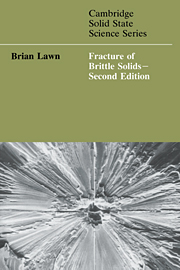Book contents
- Frontmatter
- Contents
- Preface
- Glossary of symbols and abbreviations
- 1 The Griffith concept
- 2 Continuum aspects of crack propagation I: linear elastic crack-tip field
- 3 Continuum aspects of crack propagation II: nonlinear crack-tip field
- 4 Unstable crack propagation: dynamic fracture
- 5 Chemical processes in crack propagation: kinetic fracture
- 6 Atomic aspects of fracture
- 7 Microstructure and toughness
- 8 Indentation fracture
- 9 Crack initiation: flaws
- 10 Strength and reliability
- References and reading list
- Index
5 - Chemical processes in crack propagation: kinetic fracture
Published online by Cambridge University Press: 14 January 2010
- Frontmatter
- Contents
- Preface
- Glossary of symbols and abbreviations
- 1 The Griffith concept
- 2 Continuum aspects of crack propagation I: linear elastic crack-tip field
- 3 Continuum aspects of crack propagation II: nonlinear crack-tip field
- 4 Unstable crack propagation: dynamic fracture
- 5 Chemical processes in crack propagation: kinetic fracture
- 6 Atomic aspects of fracture
- 7 Microstructure and toughness
- 8 Indentation fracture
- 9 Crack initiation: flaws
- 10 Strength and reliability
- References and reading list
- Index
Summary
In developing the Griffith–Irwin fracture mechanics of chapters 2 and 3 we presumed that equilibrium brittle fracture properties are governed by invacuo surface energies. In practice, most fractures take place in a chemically interactive environment. The effects of environment on crack propagation can be strongly detrimental. One of the most distinctive manifestations is a rate-dependent growth, even at sustained applied stresses well below the ‘inert strength’, with velocities sufficiently high as to be clearly measurable but too low as to be considered inertial. We use the term kinetics (typical velocity range ≈ m s-1 down to and below nm s-1) to distinguish from true dynamics (velocity range ≈ m s-1 to km s-1). Kinetic crack propagation (alternatively referred to as ‘slow’ or ‘subcritical’ crack growth) is notable for its extreme sensitivity to applied load, specifically to G and K. It tends also to depend on concentration of environmental species, temperature, and other extraneous variables.
How does kinetic behaviour reconcile with the Griffith concept? A crack growing at constant velocity at a specific driving force implies a condition of steady state, whereas Griffith deals explicitly with equilibrium states. Experimentally, it is found that velocity diminishes with decreasing G or K until, at some threshold, motion ceases. On unloading the system still further the crack closes up and, under favourable conditions, heals, even in the presence of environmental species.
- Type
- Chapter
- Information
- Fracture of Brittle Solids , pp. 106 - 142Publisher: Cambridge University PressPrint publication year: 1993
- 1
- Cited by



